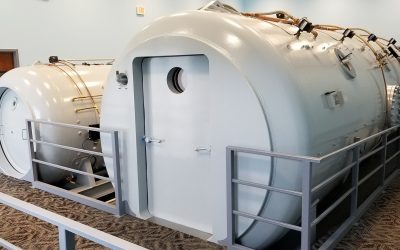Crohn’s disease is an inflammatory disease of the gastrointestinal tract, usually involving the ileum, that can lead to debilitating symptoms of abdominal pain, diarrhea and malabsorption during acute exacerbations. Because there is no known cause of the illness, treatment is based upon symptomatology and may ultimately require bowel resection if response to medical therapy is inadequate. Treatment with hyperbaric oxygen has shown promise in the reduction of inflammation associated with acute exacerbations of Crohn’s disease, with alleviation of symptoms and an improvement in quality of life. We present two cases of pediatric patients with exacerbations of Crohn’s disease who underwent cycles of hyperbaric oxygen therapy.
A favourable response to surgical intervention and hyperbaric oxygen therapy in pyoderma gangrenosum.
Pyoderma gangrenosum (PG) is a neutrophilic dermatosis characterised with ulcerations. Inflammatory bowel diseases (ulcerative colitis and Crohn’s disease) and haematologic diseases (leukaemia, preleukaemia and monoclonal gammopathy) have been reported in about 40-50% of PG patients in whom the treatment of the underlying disease is important for the improvement of the lesions. We herein report a colorectal adenocarcinoma patient with PG, who responded partially to topical treatments and systemic immunosuppressants and healed completely with the aid of surgical wound repair and hyperbaric oxygen therapy.
[Hyperbaric oxygen in the treatment of perineal Crohn’s disease era of infliximab: a renewal interest?].
Despite the growing number of therapeutic methods and the recent introduction of new drugs more active in the therapeutic arsenal, lesions of the ano-perineal Crohn’s disease remains difficult to support. Hyperbaric oxygen (HBO) was made before the era of infliximab, an interesting therapeutic approach in which the current position remains unclear. To assess HBO efficacy in the treatment of anal fistulas refractory Crohn’s disease. Literature review. Hyperbaric oxygen therapy was used in the 90’s when the biotherapy was not part of the armamentarium for Crohn’s disease. Research conducted has identified only nine publications evaluating the efficacy of hyperbaric oxygen therapy in the treatment of anal fistulas refractory Crohn’s disease.
HBOT for inflammatory bowel disease
Traditionally, hyperbaric oxygen treatment (HBOT) has been used to treat a limited repertoire of disease, including decompression sickness and healing of problem wounds. However, some investigators have used HBOT to treat inflammatory bowel disease (IBD), including Crohn’s disease and ulcerative colitis.
Comprehensive searches were conducted in 8 scientific databases through 2011 to identify publications using HBOT in IBD. Human studies and animal models were collated separately.
Hyperbaric oxygen treatment for inflammatory bowel disease: a systematic review and analysis.
Traditionally, hyperbaric oxygen treatment (HBOT) has been used to treat a limited repertoire of disease, including decompression sickness and healing of problem wounds. However, some investigators have used HBOT to treat inflammatory bowel disease (IBD), including Crohn’s disease and ulcerative colitis. Comprehensive searches were conducted in 8 scientific databases through 2011 to identify publications using HBOT in IBD. Human studies and animal models were collated separately. Thirteen studies of HBOT in Crohn’s disease and 6 studies in ulcerative colitis were identified. In all studies, participants had severe disease refractory to standard medical treatments, including corticosteroids, immunomodulators and anti-inflammatory medications.
Crohn’s disease and hyperbaric oxygen therapy.
Abstract: Evaluate the application of Hyperbaric Oxygen Therapy (HBO) in patients with Crohn's disease (CD) refractory to pharmacologic therapy, who developed abdominal, anorectal or skin complications. Fourteen selected patients with refractory CD and treated at the...
Hyperbaric oxygen stimulates vasculogenic stem cell growth and differentiation in vivo
We hypothesized that oxidative stress from hyperbaric oxygen (HBO2, 2.8 ATA for 90 min daily) exerts a trophic effect on vasculogenic stem cells.
The efficacy of hyperbaric oxygen (HBO2) for healing refractory wounds in diabetic patients and those with radiation injuries has been shown in randomized trials, and its utilization is supported by independent evidence-based reviews (6, 10, 20, 32, 38). Mechanisms of action for HBO2 are not clear. The goal of this study was to examine the impact of HBO2 on vasculogenic stem cells in an in vivo animal model.
Expanded adipose-derived stem cells for the treatment of complex perianal fistula including Crohn’s disease
In patients without Crohn’s disease, surgery is the mainstay treatment but faecal incontinence and recurrence are high. Infliximab is used in Crohn’s patients but not all respond to therapy. Objective: After an evaluation of the current treatment options, we discuss studies of adipose-derived stem cell (ASC) therapy, a novel approach for treating complex perianal fistulas.
Methods: ASCs are obtained from a liposuction procedure and a subsequent expansion process. They are administered according to a strict protocol which involves infusion of the cells into the target lesion along with fibrin glue.
Effect of hyperbaric oxygen on flow-mediated vasodilation: an ultrasound study.
Abstract: The purpose of this study was to investigate the effect of hyperbaric oxygen (HBO) treatment on flow-mediated vasodilation (FMD) by ultrasound examination. We studied 14 young patients without cardiovascular problems who underwent HBO treatment. The...
Hyperbaric oxygen therapy is as effective as dexamethasone in the treatment of TNBS-E-induced experimental colitis.
Abstract: Hyperbaric oxygen (HBO) has been demonstrated to be useful as an adjunctive therapy for Crohn's disease. In the present study, HBO was tested as a treatment for trinitrobenzenesulfonic acid-ethanol (TNBS-E)-induced distal colitis, and its effects were...



